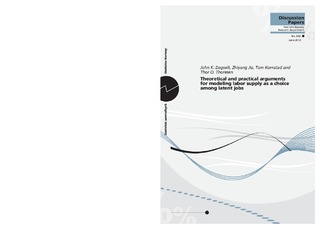| dc.contributor.author | Dagsvik, John K. | |
| dc.contributor.author | Jia, Zhiyang | |
| dc.contributor.author | Kornstad, Tom | |
| dc.contributor.author | Thoresen, Thor Olav | |
| dc.coverage.spatial | Norway | nb_NO |
| dc.date.accessioned | 2019-11-13T11:02:02Z | |
| dc.date.available | 2019-11-13T11:02:02Z | |
| dc.date.issued | 2012-06 | |
| dc.identifier.issn | 0809-733X | |
| dc.identifier.uri | http://hdl.handle.net/11250/2628174 | |
| dc.description.abstract | Models of labor supply derived from stochastic utility representations and discretized sets of feasible hours of work have gained popularity because they are more practical than standard approaches based on marginal calculus. In this paper we argue that practicality is not the only feature that can be addressed by means of stochastic choice theory. This theory also offers a powerful framework for developing a more realistic model for labor supply choices, founded on individuals having preferences over jobs and facing restrictions on the choice of jobs and hours of work. We discuss and clarify how this modeling framework deviates from both the conventional discrete approach (van Soest, 1995), as well as the standard textbook approach based on marginal calculus (Hausman, 1985). We furthermore discuss how the model based on job choice offers the possibility of conducting a richer set of simulations of alternative policies. | nb_NO |
| dc.language.iso | eng | nb_NO |
| dc.publisher | Statistisk sentralbyrå | nb_NO |
| dc.relation.ispartofseries | Discussion papers;692 | |
| dc.subject | JEL classification: C51 | nb_NO |
| dc.subject | JEL classification: J22 | nb_NO |
| dc.subject | JEL classification: H24 | nb_NO |
| dc.title | Theoretical and practical arguments for modeling labor supply as a choice among latent jobs | nb_NO |
| dc.type | Working paper | nb_NO |
| dc.description.version | publishedVersion | nb_NO |
| dc.subject.nsi | VDP::Matematikk og Naturvitenskap: 400::Matematikk: 410::Statistikk: 412 | nb_NO |
| dc.source.pagenumber | 25 | nb_NO |
